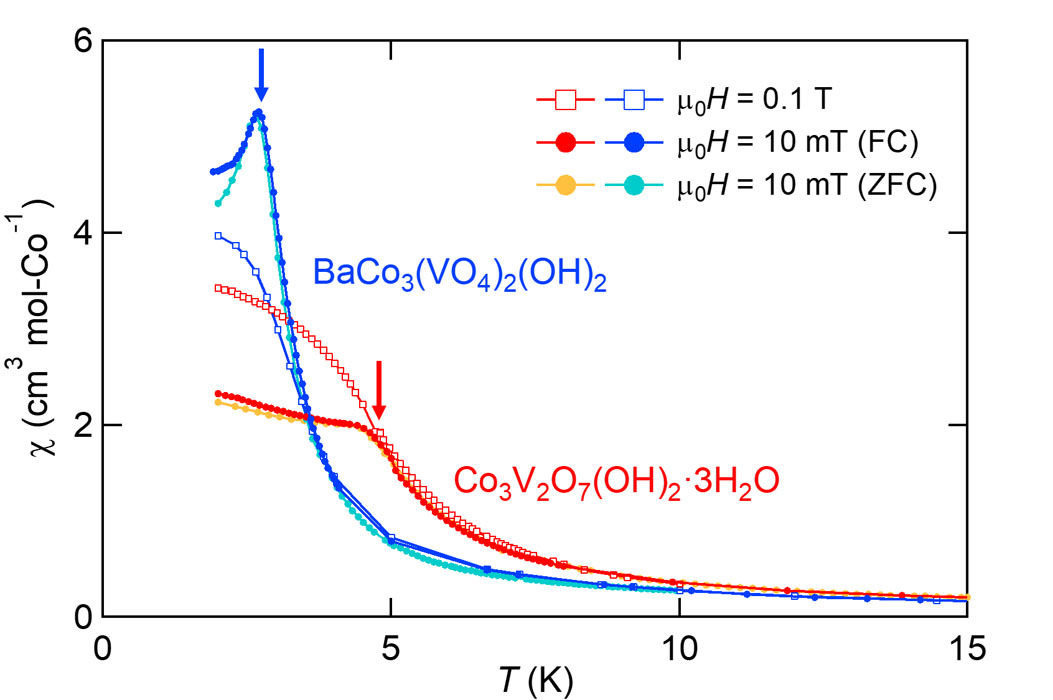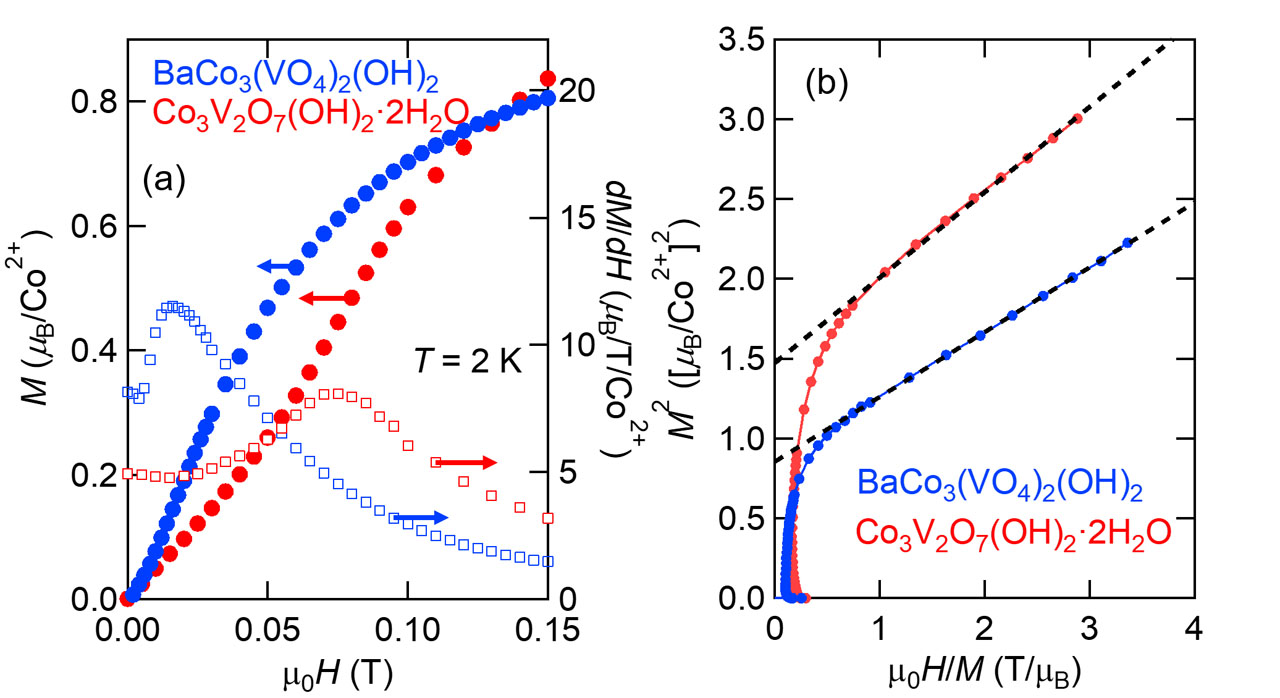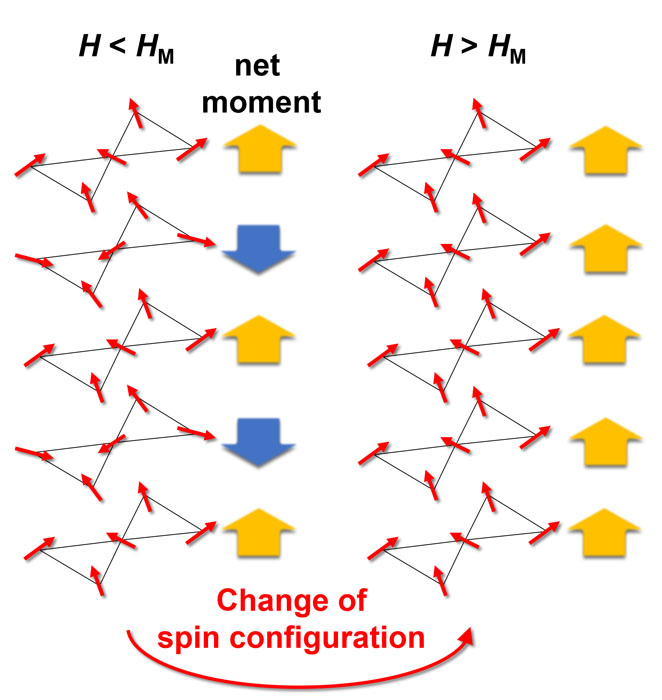Perfect Co2+-Based Jeff = 1/2 Kagomé Magnets
PI of Joint-use project: Y. Haraguchi
Host lab: Hiroi Group and Electromagnetic Measurements Section
Host lab: Hiroi Group and Electromagnetic Measurements Section
Kagomé lattice antiferromagnets have attracted significant interest in condensed matter physics due to their exotic magnetic properties, such as geometric frustration and the emergence of topologically ordered ground states. Our research aims to contribute to understanding the Jeff = 1/2 kagomé physics, which has not been comprehensively explored experimentally or theoretically. In this study, we report the synthesis, crystal structure, and magnetic properties of two cobalt-based kagomé magnets, namely Co3V2O7(OH)2·2H2O and BaCo3(VO4)2(OH)2. These compounds can be considered as Co analogs of the extensively studied quantum kagomé magnets volborthite Cu3V2O7(OH)2·2H2O and vesignieite BaCu3(VO4)2(OH)2. The titled Co2+-based kagomé materials were synthesized utilizing the hydrothermal technique. For a comprehensive understanding of the specific synthesis procedures employed in this study, please refer to the associated publication [1].
As illustrated in Figure 1, the temperature-dependent magnetic susceptibility of Co3V2O7(OH)2·2H2O and BaCo3(VO4)2(OH)2 under low magnetic fields of 10 mT displays anomalies indicative of an antiferromagnetic transition. However, this characteristic behavior vanishes when the applied magnetic field is elevated to 0.1 T. This observation can be corroborated by the isothermal magnetization process at 2 K, depicted in Figure 2(a), where the antiferromagnetic ground state is suppressed by a field-induced phase transition at considerably lower magnetic fields (75 mT for Co3V2O7(OH)2·2H2O and 16 mT for BaCo3(VO4)2(OH)2, respectively). Moreover, the M2 vs. H/M plot [Figure 2(b)] reveals a curve characteristic of metamagnetism. In the high-field region beyond the metamagnetic transition field, the M2 vs. H/M plot exhibits linearity, signifying that the order parameter within the framework of Landau theory corresponds to the spontaneous magnetization M0 (associated with the value of the intercept) and exhibits a metamagnetic feature [2].
Nevertheless, the spontaneous magnetization M0 is approximately half of the powder-averaged saturation magnetization of 2 μB anticipated for Co2+ and cannot be elucidated by simple in-plane ferromagnetism, as typically observed in metamagnetic transitions. Theoretical investigations suggest that antisymmetric exchange mediated by the Dzyaloshinsky-Moriya (DM) interaction may engender such moments by causing a slight out-of-plane tilt of the spins [3,4]. The DM interaction prompts the spins within each triangle of the kagomé lattice to adopt an "umbrella" configuration [5]. If the Co2+ ion exhibits a Jeff = 1/2 effective spin, the powder-averaged g factor is approximately 4. The angle θ, representing the spin tilt induced by the DM interaction, is nearly equal to arctan[(g-2)/g]. Consequently, the emergent ferromagnetic moment in Co2+ spin is approximately 45% of the saturation magnetization, which explains the magnetic moment that emerges due to the metamagnetic transition, constituting nearly half of the saturation field.
Based on these observations, the origin of the metamagnetic transition in Co2+ kagomé systems can be elucidated as portrayed in Figure 3. The relatively substantial DM interaction provokes each triangular spin of the kagomé lattice to adopt a significantly tilted umbrella structure, generating a ferromagnetic moment of about M0 ~ 1 μB on each kagomé plane. The coupling between kagomé planes is characterized by weak antiferromagnetic interactions between layers of ferromagnetic moments under a feeble applied magnetic field. Furthermore, the antiferromagnetic coupling becomes destabilized by weak magnetic fields on the order of tens of millitesla, culminating in "halfway-saturated ferromagnetism."
Our study highlights the importance of synthesizing and characterizing new materials with kagomé lattice structures to broaden the understanding of the Jeff = 1/2 kagomé physics. Furthermore, the Co2+ kagomé magnets presented here serve as a platform for further investigations of the interplay between crystal-field, superexchange, spin-orbit coupling, and DM interactions in kagomé systems.
References
- [1] Y. Haraguchi, T. Ohnoda, A. Matsuo, K. Kindo, and H. Aruga Katori, Physical Review B 106, 214421 (2022).
- [2] S. K. Banerjee, Phys. Lett. 12, 16 (1964).
- [3] I. E. Dzyaloshinskii, J. Phys. Chem. Solids 4, 241 (1958).
- [4] T. Moriya, Phys. Rev. 120, 91 (1960).
- [5] M. Elhajal, B. Canals, and C. Lacroix, Phys. Rev. B 66, 014422 (2002).



